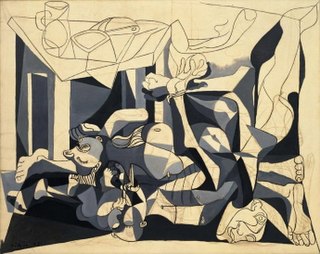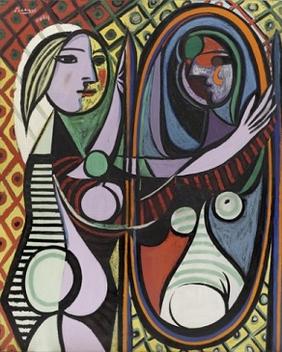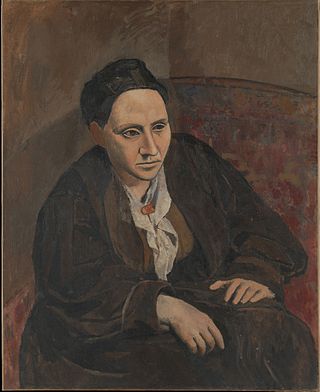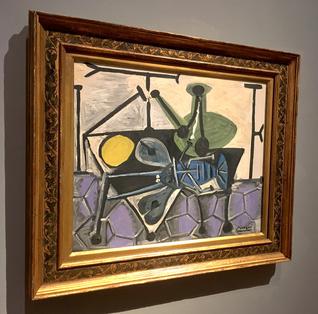Related Research Articles

Georges Braque was a major 20th-century French painter, collagist, draughtsman, printmaker and sculptor. His most notable contributions were in his alliance with Fauvism from 1905, and the role he played in the development of Cubism. Braque's work between 1908 and 1912 is closely associated with that of his colleague Pablo Picasso. Their respective Cubist works were indistinguishable for many years, yet the quiet nature of Braque was partially eclipsed by the fame and notoriety of Picasso.

Pablo Ruiz Picasso was a Spanish painter, sculptor, printmaker, ceramicist, and theatre designer who spent most of his adult life in France. One of the most influential artists of the 20th century, he is known for co-founding the Cubist movement, the invention of constructed sculpture, the co-invention of collage, and for the wide variety of styles that he helped develop and explore. Among his most famous works are the proto-Cubist Les Demoiselles d'Avignon (1907) and the anti-war painting Guernica (1937), a dramatic portrayal of the bombing of Guernica by German and Italian air forces during the Spanish Civil War.

Cubism is an early-20th-century avant-garde art movement begun in Paris that revolutionized painting and the visual arts, and influenced artistic innovations in music, ballet, literature, and architecture. Cubist subjects are analyzed, broken up, and reassembled in an abstract form—instead of depicting objects from a single perspective, the artist depicts the subject from multiple perspectives to represent the subject in a greater context. Cubism has been considered the most influential art movement of the 20th century. The term cubism is broadly associated with a variety of artworks produced in Paris or near Paris (Puteaux) during the 1910s and throughout the 1920s.

Guernica is a large 1937 oil painting by Spanish artist Pablo Picasso. It is one of his best-known works, regarded by many art critics as the most moving and powerful anti-war painting in history. It is exhibited in the Museo Reina Sofía in Madrid.

Les Demoiselles d'Avignon is a large oil painting created in 1907 by the Spanish artist Pablo Picasso. Part of the permanent collection of the Museum of Modern Art in New York, it portrays five nude female prostitutes in a brothel on Carrer d'Avinyó, a street in Barcelona, Spain. The figures are confrontational and not conventionally feminine, being rendered with angular and disjointed body shapes, some to a menacing degree. The far left figure exhibits facial features and dress of Egyptian or southern Asian style. The two adjacent figures are in an Iberian style of Picasso's Spain, while the two on the right have African mask-like features. Picasso said the ethnic primitivism evoked in these masks moved him to "liberate an utterly original artistic style of compelling, even savage force” leading him to add a shamanistic aspect to his project.
The Blue Period comprises the works produced by Spanish painter Pablo Picasso between 1901 and 1904. During this time, Picasso painted essentially monochromatic paintings in shades of blue and blue-green, only occasionally warmed by other colors. These sombre works, inspired by Spain and painted in Barcelona and Paris, are now some of his most popular works, although he had difficulty selling them at the time.

Picasso's African Period, which lasted from 1906 to 1909, was the period when Pablo Picasso painted in a style which was strongly influenced by African sculpture, particularly traditional African masks and art of ancient Egypt, in addition to non-African influences including Iberian sculpture, and the art of Paul Cézanne and El Greco. This proto-Cubist period following Picasso's Blue Period and Rose Period has also been called the Negro Period, or Black Period. Picasso collected and drew inspiration from African art during this period, but also for many years after it.

The Weeping Woman is a series of oil on canvas paintings by Pablo Picasso, the last of which was created in late 1937. The paintings depict Dora Maar, Picasso's mistress and muse. The Weeping Woman paintings were produced by Picasso in response to the bombing of Guernica in the Spanish Civil War and are closely associated with the iconography in his painting Guernica.

Three Musicians, also known as Musicians with Masks or Musicians in Masks, is a large oil painting created by Spanish artist Pablo Picasso. He painted two versions of Three Musicians. Both versions were completed in the summer of 1921 in Fontainebleau near Paris, France, in the garage of a villa that Picasso was using as his studio. They exemplify the Synthetic Cubist style; the flat planes of color and "intricate puzzle-like composition" giving the appearance of cutout paper with which the style originated. These paintings each colorfully represent three figures wearing masks. The two figures in the center and left are wearing the costumes of Pierrot and Harlequin from the popular Italian theater Commedia dell'arte, and the figure on the right is dressed as a monk. In one version, there also is a dog underneath the table.

The Charnel House is an unfinished 1944–1945 oil and charcoal on canvas painting by Spanish artist Pablo Picasso, which is purported to deal with the Nazi genocide of the Holocaust. The black and white 'grisaille' composition centres on a massed pile of corpses and was based primarily upon film and photographs of a slaughtered family during the Spanish Civil War. It is considered to be the second of three major anti-war Picassos, preceded by Guernica in 1937 and succeeded by Massacre in Korea in 1951. The painting is housed in the Museum of Modern Art in New York City.

The Accordionist is a 1911 oil on canvas painting by Pablo Picasso. The painting portrays a seated man playing an accordion. The division of three-dimensional forms into a two-dimensional plane indicates that the painting is in the style of Analytical Cubism, which was developed by Picasso and Georges Braque between 1907 and 1914. The painting is now in the Solomon R. Guggenheim Museum in New York City.

Ma Jolie is an oil on canvas painting by Spanish artist Pablo Picasso, which is located in the Indianapolis Museum of Art, in Indianapolis, Indiana, US. Completed in 1914, its fractured depiction of everyday objects is an example of Cubism. It is not to be confused with the 1912 Picasso of the same name, which is now in the Museum of Modern Art in New York.

La Vie is a 1903 oil painting by Pablo Picasso. It is widely regarded as the pinnacle of Picasso's Blue Period.

Science and Charity is an oil on canvas painting by Pablo Picasso, which he painted in Barcelona in 1897. It is an example of one of Picasso's earliest works, as he painted it when he was only 15 years old. The painting depicts a formal composition of a sick patient in bed, attended by a doctor and a nun holding a child. It was the culmination of Picasso's academic training and displays his talent as an artist before he moved away from this style to pursue his own artistic career. The painting is housed in the collection of the Museu Picasso, Barcelona.

Girl before a Mirror(French: Jeune fille devant un miroir) is an oil on canvas painting by Pablo Picasso, which he created in 1932. The painting is a portrait of Picasso's mistress and muse, Marie-Thérèse Walter, who is depicted standing in front of a mirror looking at her reflection. It is housed in the collection of the Museum of Modern Art in New York City.

Les Femmes d'Alger is a series of 15 paintings and numerous drawings by the Spanish artist Pablo Picasso. The series, created in 1954–1955, was inspired by Eugène Delacroix's 1834 painting The Women of Algiers in their Apartment. The series is one of several painted by Picasso in tribute to artists that he admired.
Woman Ironing is a 1904 oil painting by Pablo Picasso that was completed during the artist's Blue Period (1901—1904). This evocative image, painted in neutral tones of blue and gray, depicts an emaciated woman with hollowed eyes, sunken cheeks, and bent form, as she presses down on an iron with all her will. A recurrent subject matter for Picasso during this time is the desolation of social outsiders. This painting, as the rest of his works of the Blue Period, is inspired by his life in Spain but was painted in Paris.

Portrait of Gertrude Stein is an oil-on-canvas painting of the American writer and art collector Gertrude Stein by Pablo Picasso, which was begun in 1905 and finished the following year. The painting is housed in the Metropolitan Museum of Art in New York. It is considered one of the important works of Picasso's Rose Period. The portrait has historical significance, due to the subject's role in Picasso's early life as a struggling artist and eventual commercial success. It also represents a significant transitional step in the artist's move towards Cubism.

Nature morte au poron is a 1948 oil-on-canvas painting by Pablo Picasso. It is a still-life painting in a cubist style. Picasso painted three versions of the work on 26 December 1948; one is in the collection of the Welsh National Museum of Art, Cardiff, Wales. The painting measures 50.3 × 61 cm.

The American People Series #20: Die is an oil on canvas painting made by American artist Faith Ringgold in 1967. Inspired by Pablo Picasso's painting Guernica (1937) and painted amidst the riots and uprisings of the 1960s, Die is a two-panel work depicting a group of Black and white men, women, and children, most of whom are wounded or covered in blood, variously fighting, fleeing, or dying against an abstract grey background. The piece has been extensively cited as among Ringgold's most important and iconic artworks.
References
- 1 2 Lanchner, Carolyn (2008). Pablo Picasso. Museum of Modern Art. pp. 27–30. ISBN 9780870707230.
- ↑ Umland, Anne; Ferrari, Francesca; Morrison, Alexandra; Museum of Modern Art (New York, N.Y.), eds. (2023). Picasso in Fontainebleau. New York: The Museum of Modern Art. ISBN 978-1-63345-139-1. OCLC 1400088223.
- ↑ "Three Women at the Spring". Museum of Modern Art . Retrieved 2024-05-01.